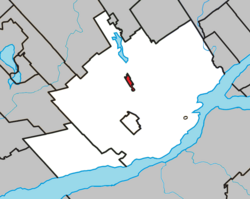Wendake
You can help expand this article with text translated from the corresponding article in French. (September 2013) Click [show] for important translation instructions.
|
Wendake | |
|---|---|
 The Place de la nation huronne-wendat in Wendake | |
 Location of Wendake within the Québec equivalent territory | |
| Coordinates: 46°51′41.3″N 71°21′25.6″W / 46.861472°N 71.357111°W | |
| Country | |
| Province | |
| Equivalent territory | Québec |
| First Nation | Huron-Wendat |
| Government | |
| • Grand Chief | Konrad Sioui |
| Area | |
| • Total | 1.64 km2 (0.63 sq mi) |
| Population (2016) | |
| • Total | 2,134 |
| • Density | 1,301/km2 (3,370/sq mi) |
| Time zone | UTC−5 (EST) |
| • Summer (DST) | UTC−4 (EDT) |
| Postal code | |
| Area code(s) | 418 and 581 |
| Website | wendake |
Wendake is the current name for an urban reserve of the Huron-Wendat Nation in the Canadian province of Quebec. It is an enclave entirely surrounded by the La Haute-Saint-Charles borough of Quebec City, within the former city of Loretteville. One of the Seven Nations of Canada, the settlement was formerly known as Village-des-Hurons ("Huron Village"), and also as (Jeune)-Lorette ("New Lorette").
Since the late 20th century, archeologists have found large 16th-century villages of the Wendat (Huron) in the northern Lake Ontario region, which is where they believe the people coalesced as a distinct group. Later they migrated south and by the early 17th century had settled in their historical territory of Wendake in the Georgian Bay region. The Wyandot Confederation was made up of loosely associated tribes who spoke a mutually intelligible Iroquoian language.[1]
History

Archeologists have excavated 16th-century settlements north of Lake Ontario at the Mantle Site (2005), Aurora Site and Ratcliff Site in Whitchurch-Stouffville, Ontario, all attesting to distinctly Wendat (Huron) occupancy. They have concluded the people coalesced in this area as a distinct group. Later they migrated to the Georgian Bay area, where they encountered Europeans in the 17th century.
Until the middle of the 17th century, the Wendake ancestors occupied a vast territory [citation needed] straddling part of what is now the United States (from Detroit as far south as Oklahoma)[citation needed], south-eastern Ontario (Penetanguishene and Midland) and Quebec. They hunted and trapped throughout this territory (mainly in the Laurentian Mountains, between the central section of the Saint-Maurice and the Saguenay rivers).
Between 1634 and 1650, the Wyandot Confederation was dismembered; its families, having been gathered into four or five tribes, were dispersed. It is estimated that the Huron population totalled approximately 20,000 to 30,000 people in 1634. By 1650, only a few hundred individuals remained. Most had been decimated by infectious disease epidemics, to which they had no natural immunity; survivors were attacked by wars, especially by the Iroquois Confederacy, who pushed from the south (present-day New York) trying to control hunting grounds and the fur trade.
Part of the Huron population had also been integrated into the Iroquois Confederation. The survivors of this tragic period divided into two groups in Canada: the Great-Lake Wyandot and the Huron-Wendat. The latter were the ancestors of the Huron-Wendat of Wendake. This marked the beginning of a period of exile for the 300 or so Wendat who remained, an era during which they would occupy as many as six different sites in the province of Quebec. They finally settled for good in the village of Lorette in 1697. First established on Île d'Orléans in 1651, the community moved to Quebec City in 1668. Subsequently, the Wendat temporarily resided in Beauport, Notre Dame de Foy, Ancienne-Lorette and then New Lorette in 1673.
The current population of the Indian reserve is 2,134 persons (2016 census). The land area is only 1.46 km² (about 360 acres). The leader of Wendake is Grand Chef Konrad Sioui, who succeeded Max Gros-Louis in 2008.
The Huron had called their historic homeland Wendake; it was the territory south of Georgian Bay in present-day Simcoe and Grey counties. The region was informally known as "Huronia" or the Georgian Triangle. A very large 15th-century Huron-Wendat settlement (the Mantle Site) has recently been discovered in Whitchurch–Stouffville. Its discovery has added to archeologists and anthropologists believing that the Wendat arose as a people in this area.
Other remnants of the Wendat and Petun peoples formed the Wyandot and migrated south, to present-day Michigan, and later to Indian Territory in Kansas and Oklahoma. In the United States, there are three federally recognized Wyandot tribes: the Wyandotte Nation of Oklahoma, the Wyandot Nation of Kansas, and the Wyandot Nation of Anderdon in Michigan. In August 1999, these nations joined the contemporary Wendat Confederacy, pledging to provide mutual aid to each other in a spirit of peace, kinship, and unity.[2]
References
- ^ "The Native Peoples". Wyandotte Nation. Retrieved 30 June 2018.
- ^ "The Wendat Confederacy", August 27, 1999, Wyandotte Nation of Oklahoma. 2008 (retrieved February 2, 2009)


